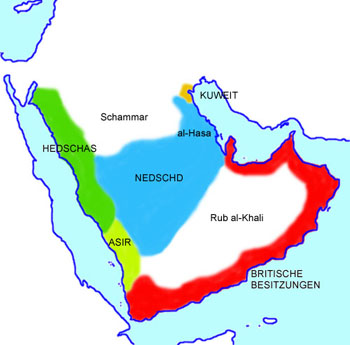mobile View, to the German Version tap the flag


- Emirate of Asir
- former Emirate on the Red Sea
- nowadays province of Saudi Arabia
• Flags
• Meaning/Origin of the Flag
• Map
• Numbers and Facts
• History
• Origin of the Country's Name
A special feature of the flags on this website is an inscription with Arabic script. In European understanding, any inscription on a flag is considered to be on the front of the flag, the writing always running from left to right, so that the respective inscription starts next to the pole on the left and continues to the right - towards the waving end of the flag. The Arabic script, however, is read from right to left. The European way of understanding at these things should not be applied to flags with Arabic inscriptions, because if the pole were on the left, the Arabic writing would run from the waving end towards the pole, which is not allowed. Sometimes this argument is reinforced by illustrations, e.g. a sword with the tip of the sword pointing towards the end of the shahada. If one wants to show this correctly on this type of flag, the writing must run away from the mast, Arabic from right to left, the sword then also pointing from right to left, which means that the mast must necessarily be on the right. In order to use this type of flag correctly, two front sides must be sewn against each other, a mirror-inverted print-through would not be appropriate.



1909–1927,
National flag,
ratio = 1:2,
Source, by: World Statesmen





1927–1934,
National flag,
ratio = 1:2,
Source, by: World Statesmen




The first flag of the Emirate of Asir was adoped in the year 1909, still in the times of the revolt against the Turks, but the independence came not until the year 1916. It showed a single-coloured green bunting and on it in two lines, in white arabian letters, the Shahada, the credo of the Islam ("Allah il Allah, wa Muhammad rasul Allah" → "There is no God but God; and Mohammed is His messenger"). Besides the pole-side the flag showed a border from small white triangles. As Asir became a protectorate of the State of Nadjd, the border was removed from the flag. That was done either to make possible a better differentiation from the flag of Nadjd, which had in that times a white border too, or to point out the loss of state sovereignty. The colour green is probably the colour of the dynasty of the Idrisides, because the colour green is used by families which trace back their descent directly to Mohammed. The colour green was the colour of the coat of the Prophet Mohammed. In that times (even in Europe) it was sometimes usual to use garments as flag. In this way as well with the coat of Mohammed. The colour of the coat became in this way very quick to colour and flag of the Islam, and especially to the colour of the Fatimids, an Ismailic-Shiite dynasty of Califs, which have their roots in the fourth Calif Ali, and Fatima, the daughter of Mohammed.
Source: Volker Preuss

Clickable Map of the Arabian Peninsula ca. 1920:

Map: Volker Preuss

today's Province of Asir:
Area: 29.610 square miles
Inhabitants: 1.861.400 (nowadays)
Capital: Abha
Source: Wikipedia (D)

4th–6th century · Empire of the Himjarits in Asir and Yemen, partial christianization
ca. 560 · the Persian Sassanids control the coast of the Empire of the Himjarits
572–628 · to the Empire of the Sassanids (Persia)
628 · islamic conquest, islamization
10th–13th century · to the State of Yemen
1583 · conquest by the Ottoman Empire
18th century · Emirate of Asir under the dynasty of the Chayratidas, under Ottoman supremacy, waxing pressure of the Wahabits from Nadjd
1811–1818 · Egyptian troops under Mohammed Ali destroy the Wahabit-State of the Saud in Nadjd, Asir becomes an Egyptian zone of influence
1823 · Emirate of Asir under the dynasty of the Aidids
1872–1916 · Asir is again a part of the Ottoman Empire
1910–1916 · Anti-Turkish revolt (with Italian support) under the leadership of the local dynasty of the Idrisids
1916–1927 · independent Emirate of Asir under the dynasty of the Idrisids
1923 · extensive ceding of territories to Nadjd and the United Kingdom
1927–1934 · Asir is a protectorate of Nadjd (since 1932 Saudi Arabia)
1930 · Asir becomes governmentally affiliated to Hedjas
1932 · war between Saudi Arabia and Yemen, invasion of Saudi troops in Asir, annexation of Asir by Saudi Arabia
20th of May 1934 · Peace of Taif between Saudi Arabia, Yemen, Italy and United Kingdom: Saudi Arabia retreats from Yemen, but the annexation of Asir by Saudi Arabia becomes recognized
Source: Atlas zur Geschichte,
Wikipedia (D),
World Statesmen,
Kleine Enzyklopädie Weltgeschichte

To explain the origin of the name "Asir" exist two theories:
1st) "Asir" is Arabian and means "hard land", although it is a very fruitful region;
2nd) the name comes from the tribe of the "Asiri", which lived in Upper Asir near Abha.
Source: Wikipedia (D),
RetroBib Retrobibliothek


![]()






